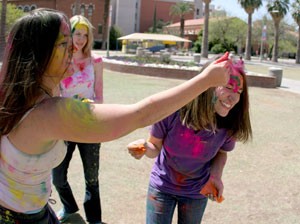At first sight, it seemed a strange bomb went off yesterday on the UA Mall, causing about 100 people to be covered head to toe with green and yellow paint.
But upon closer inspection, it was the first-ever Holi Hai festival, a traditional celebration of spring put on by the South Asian Student Cultural Association.
“”The event is not just to strengthen the South Asian community, it’s meant to strengthen the entire Tucson community,”” said Lalita Abhyankar, SASCA president and a biochemistry junior.
Another reason for the event, she said, was to promote awareness of the South Asian community at the UA, adding that yesterday some people even asked her where South Asia is.
That was why the festival was open to the public, she said.
“”It’s a great event because it gives exposure for South Asian awareness,”” said Dan Xayaphanh, senior retention coordinator for the Office of Asian Pacific American Student Affairs.
About 25 people took part in throwing Holi, bags filled with colorful powders meant to be joyfully thrown at friends to celebrate the end of winter and the coming of spring.
“”Mostly children and us are the only ones not reluctant to throw Holi,”” said Morgan Sim, a political science junior, as she stood standing in a group of drenched students. “”The shower after Holi is going to be hilarious.””
Many people were lured to the festival by the tantalizing smell of traditional Indian samosas – fried, doughy wraps served at noon and subsequently devoured by children, students and professors.
Other attractions included mehndi, threading and kite-flying. Both mehndi and threading are traditional Indian grooming techniques demonstrated by special guest Rashmi Kumar during the festival.
Mehndi, better known as henna, is a decorative dye used for centuries by South Asian women, Kumar said.
Threading is an eyebrow-grooming technique that utilizes a small string dragged along the forehead, she said.
“”It doesn’t hurt, and we hope a lot of people are willing to try it so they can learn about our culture,”” Kumar said.
Yaseen Noorani, a Near Eastern studies professor, said he brought his son to the festival so he can experience South Asian culture and have the chance to throw Holi.
“”My professor told us about the event, so we had to come to check it out and throw some Holi at one another,”” said public health senior Stacy Smith.
As the festival came to a close around 1 p.m., people walked off in all directions, globs of colorful hallucination.
“”It’s a wonderful day for having an outdoor event like this,”” Kumar said.









